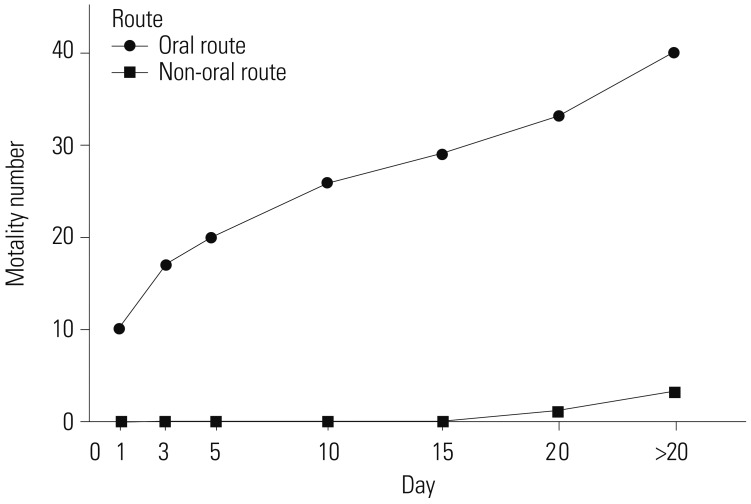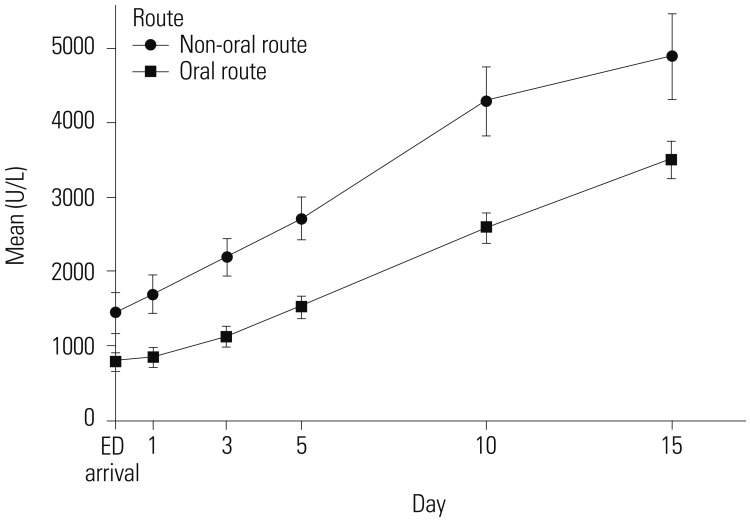Yonsei Med J.
2018 Oct;59(8):982-988. 10.3349/ymj.2018.59.8.982.
Relative Risk and Clinical Severity Assessment in Patients with Non-Oral Route Organophosphate Poisoning Compared with Oral Route Poisoning
- Affiliations
-
- 1Department of Emergency Medicine, Yonsei University Wonju College of Medicine, Wonju, Korea. erdoc74@gmail.com
- 2Center of Biomedical Data Science, Yonsei University Wonju College of Medicine, Wonju, Korea.
- 3Department of Medical Education, Yonsei University Wonju College of Medicine, Wonju, Korea.
- KMID: 2419733
- DOI: http://doi.org/10.3349/ymj.2018.59.8.982
Abstract
- PURPOSE
Organophosphates, commonly used in agricultural pesticides, pose high risks and incidences of poisoning. In the present study, we investigated the relative risk and clinical severity, including laboratory results, of non-oral route poisoning (NORP) patients, compared to oral route poisoning (ORP) patients.
MATERIALS AND METHODS
A single institutional toxicology database registry was utilized to gain information on clinical laboratory results on organophosphate poisoning patients who visited the emergency department (ED) between January 2000 and October 2016. Clinical outcomes, such as mortality and complication rates, were compared using 1:2 propensity score matching in the total cohort.
RESULTS
Among a total of 273 patients in our study, 34 experienced NORP. After 1:2 propensity score matching, rates of respiratory complications and mortality were higher in the ORP group than in the NORP group. However, there was no difference in hospitalization time and time spent in the intensive care unit between the two groups. Compared with ORP patients after matching, the relative risk of mortality in NORP patients was 0.34, and the risk of respiratory distress was 0.47. The mean level of pseudocholinesterase was significantly higher in the NORP group than in the ORP group, while recovery rates were similar between the two groups.
CONCLUSION
Although the majority of NORP patients were admitted to the ED with unintentional poisoning and the relative risk of NORP was lower than that for ORP, we concluded that NORP is as critical as ORP. Considerable medical observation and intensive therapeutic approaches are also needed for NORP patients.
Keyword
MeSH Terms
Figure
Reference
-
1. Jeyaratnam J. Acute pesticide poisoning: a major global health problem. World Health Stat Q. 1990; 43:139–144. PMID: 2238694.2. Balali-Mood M, Balali-Mood K, Moodi M, Balali-Mood B. Health aspects of organophosphorous pesticides in asian countries. Iran J Public Health. 2012; 41:1–14.3. Korean Rural Development Administration. The status of registred pesticide products. accessed on 2018 March 1. Available at: http://pis.rda.go.kr/registstus/agchmRegistStus/prdlstInqire.do.4. Aygun D, Doganay Z, Altintop L, Guven H, Onar M, Deniz T, et al. Serum acetylcholinesterase and prognosis of acute organophosphate poisoning. J Toxicol Clin Toxicol. 2002; 40:903–910. PMID: 12507060.
Article5. Yang PY, Lin JL, Hall AH, Tsao TC, Chern MS. Acute ingestion poisoning with insecticide formulations containing the pyrethroid permethrin, xylene, and surfactant: a review of 48 cases. J Toxicol Clin Toxicol. 2002; 40:107–113. PMID: 12126181.
Article6. London L, Flisher AJ, Wesseling C, Mergler D, Kromhout H. Suicide and exposure to organophosphate insecticides: cause or effect? Am J Ind Med. 2005; 47:308–321. PMID: 15776467.
Article7. Yurumez Y, Durukan P, Yavuz Y, Ikizceli I, Avsarogullari L, Ozkan S, et al. Acute organophosphate poisoning in university hospital emergency room patients. Intern Med. 2007; 46:965–969. PMID: 17603234.
Article8. Tsai JR, Sheu CC, Cheng MH, Hung JY, Wang CS, Chong IW, et al. Organophosphate poisoning: 10 years of experience in southern Taiwan. Kaohsiung J Med Sci. 2007; 23:112–119. PMID: 17389175.
Article9. Van der Hoek W, Konradsen F, Athukorala K, Wanigadewa T. Pesticide poisoning: a major health problem in Sri Lanka. Soc Sci Med. 1998; 46:495–504. PMID: 9460829.
Article10. Eddleston M, Phillips MR. Self poisoning with pesticides. BMJ. 2004; 328:42–44. PMID: 14703547.
Article11. World Health Organization. The world health report 2002: reducing risks, promoting healthy life. Geneva, Switzerland: World Health Organization;2002.12. Liang Y, Tong F, Zhang L, Li W, Huang W, Zhou Y. Fatal poisoning by terbufos following occupational exposure. Clin Toxicol (Phila). 2018; 56:140–142. PMID: 28681657.
Article13. Rubio CR, Felipe Fernández C, Manzanedo Bueno R, Del Pozo BA, García JM. Acute renal failure due to the inhalation of organophosphates: successful treatment with haemodialysis. Clin Kidney J. 2012; 5:582–583. PMID: 26069807.
Article14. Wang CY, Wu CL, Tsan YT, Hsu JY, Hung DZ, Wang CH. Early onset pneumonia in patients with cholinesterase inhibitor poisoning. Respirology. 2010; 15:961–968. PMID: 20663095.
Article15. Knaus WA, Draper EA, Wagner DP, Zimmerman JE. APACHE II: a severity of disease classification system. Crit Care Med. 1985; 13:818–829. PMID: 3928249.
- Full Text Links
- Actions
-
Cited
- CITED
-
- Close
- Share
- Similar articles
-
- Different Clinical Features of Organophosphate Insecticides Intoxication According to The Route of Administration: Disparity Between Clinical Severity And Plasma Cholinesterase Level
- A Case of Intermediate Syndrome of Organophosphate Poisoning after Dermal Exposure
- Effect of oral D-penicillamine in Urinary excretion of lead
- Study on Current Changes of Atropine Regimen in Organophosphate Pesticides Poisoning
- A Case of Amitraz Poisoning Initially Misdiagnosed as Acute Organophosphate Insecticide Poisoning



